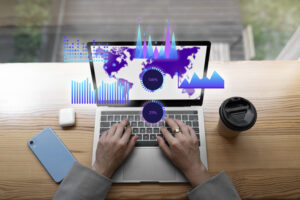Interpreting Data Science Innovations with Effective Visualizations

In the swiftly evolving landscape of data science, mastering visualization techniques has become a critical skill. These techniques adeptly transform complex, extensive data sets into narratives that are both insightful and easily understandable. Data scientists are increasingly turning to data visualization as a key method to make their sophisticated analyses both accessible and visually engaging.
Visualization: Crafting Visual Narratives from Complex Data
The art of data visualization is pivotal in its ability to simplify and translate intricate data into more straightforward visual formats such as diagrams, charts, and graphs. This crucial process makes dense data sets more accessible and intelligible to a wide range of audiences, not limited to those with technical know-how. Data scientists utilize a spectrum of visualization methods, including interactive heatmaps, fluid dashboards, and creative infographics, to transform complex numerical data into captivating and informative visual stories.
Diverse Visualization Approaches for In-depth Analysis
Data visualization employs various approaches, each tailored to specific types of data analysis. Scatter plots are ideal for demonstrating relationships between variables, bar charts effectively compare quantities, and line graphs are used to trace trends over time. Word clouds offer a visual depiction of textual data, emphasizing frequently used words. Contemporary visualization techniques, such as 3D models and virtual reality (VR) environments, are pushing the envelope, offering novel, interactive ways to analyze and interact with data.
Enhancing Clarity and Decision-Making with Visual Tools
Visual tools are indispensable in aiding stakeholders to discern and interpret data patterns, trends, and deviations. This enhanced clarity is foundational for informed decision-making, enabling organizations to formulate strategies rooted in solid data analysis. Visualizations play a critical role in spotlighting crucial insights, including market tendencies, consumer behaviors, and operational bottlenecks.
Visualization’s Role in Data Quality Assurance and Collaborative Dynamics
Visualization is key in identifying and addressing data quality issues, like discrepancies or missing elements, early in the analytical process. It also fosters collaboration among various teams, encouraging a cohesive, data-centric approach to solving problems.
The Power of Storytelling in Data Visualization
Effective visualization transcends basic data presentation; it weaves a story. This storytelling capability enables data scientists to encapsulate their analytical results within a broader context, engaging audiences more deeply and making the insights more impactful and memorable.
Ethical Implications in Visual Data Representation
Despite its myriad advantages, data visualization also encounters ethical challenges. Misrepresentation of data, whether through scale distortion or selective data depiction, is a significant concern. Data scientists are responsible for ensuring their visual representations are both accurate and ethical, maintaining the integrity of the data.
Future Directions in Data Visualization
 Looking ahead, data visualization is on the cusp of further innovation. The incorporation of artificial intelligence (AI) and machine learning into visualization processes is making data interpretations more sophisticated. The advent of augmented reality (AR) and VR in visualization is introducing more immersive, interactive ways to engage with and understand data.
Looking ahead, data visualization is on the cusp of further innovation. The incorporation of artificial intelligence (AI) and machine learning into visualization processes is making data interpretations more sophisticated. The advent of augmented reality (AR) and VR in visualization is introducing more immersive, interactive ways to engage with and understand data.
An Essential Element in Data Science
Visualization stands as an essential element in the domain of data science, acting as a vital link between complex data analysis and its practical application in a business context. By transforming data into visually compelling and insightful narratives, data scientists equip organizations with the means to derive actionable insights, make well-informed decisions, and maintain a competitive stance in a data-centric business world. As technology continues to advance, the field of data visualization is expected to evolve further, offering even more innovative and creative methods for the interpretation and presentation of intricate data stories.
